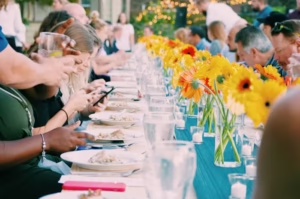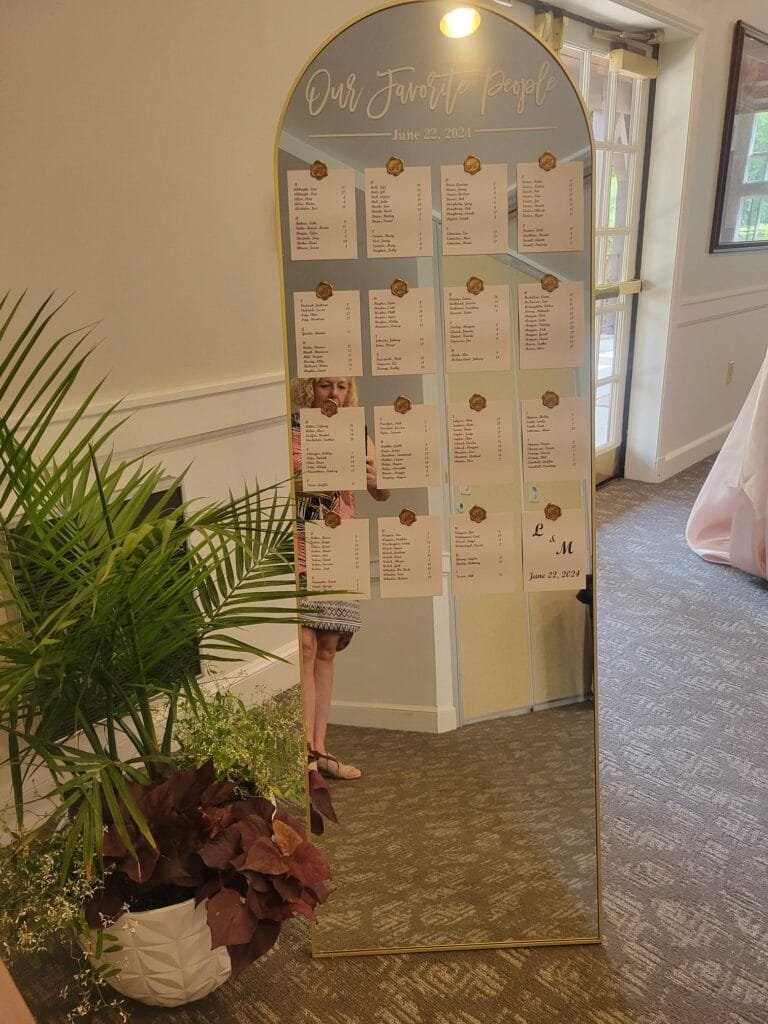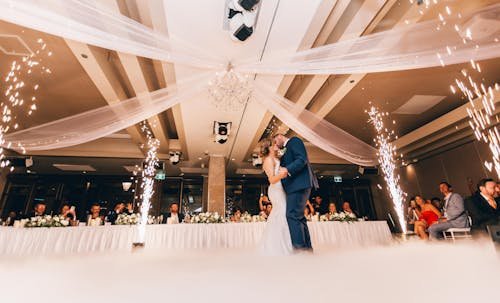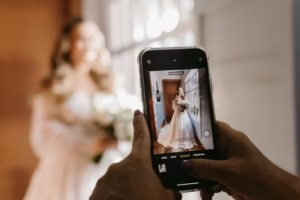13 Common Wedding Seating Chart Mistakes (and What to Do Instead)
1. Skipping the Seating Chart Altogether
Letting guests pick their own seats may sound relaxed, but it usually creates stress, cliques, awkwardness, and empty chairs. You will also end up needing more center pieces due to the extra tables needed because guests will not fill in the tables.
Do this instead: Even for casual weddings, assigned tables give guests structure and prevent confusion. Escort cards or a simple chart go a long way in making everyone feel welcome and comfortable.
2. Not Numbering or Misnumbering Tables
Random or illogical table arrangements can cause traffic jams, confusion, and late dinner service.
Better approach: Number tables in a clear pattern, either clockwise from the entrance or by sections. If you’re naming tables, also include numbers and organize the seating chart alphabetically by guest name, not by table. Do not make it too difficult for guests to find their table.
3. Leaving Out a Guest
There’s nothing more uncomfortable than a guest realizing they don’t have a seat.
Avoid this by: Triple-checking your RSVP list, having a central guest tracking system, and asking a trusted friend to review your final plan for missing names. Better yet, use Chap GTP to compare lists and make sure no names are missing.
4. Forgetting About Your VIPs
Your closest people, parents, grandparents, and bridal party, shouldn’t feel like an afterthought.
What works: Designate great-view, easily accessible tables for them. Whether you go with a head table, sweetheart table, or family-style seating, make sure they feel honored and special.
5. Overstuffing Tables

Just because a table seats 10 doesn’t mean it comfortably seats 10, especially with chargers, centerpieces, and glassware.
Do this instead: Round down. Leave breathing room for guests to eat and move without elbow battles.
6. Not Planning for Last-Minute Changes
Unexpected plus-ones or last-minute no-shows are common.
Pro solution: Set aside a “swing table” with a couple of open seats. If unused, just remove the place settings before dinner begins, or leave them; no one will notice.
7. Seating Young Adults at the Kids’ Table

Putting college-aged cousins with toddlers can come off as dismissive.
Try this: Group twenty-somethings together or seat them with family and friends they know. Keep the kids’ table exclusively for little ones under 10. Also, provide some activities at this table to keep the little ones engaged.
8. Trying to Force New Friendships

Mixing strangers “just to help them mingle” usually backfires.
Better idea: Let people sit with those they know or have something in common with. Weddings are a celebration, not a networking event, or the high school cafeteria.
9. Placing Guests at the Outskirts with No Connection
Outlying tables can feel like social exile, especially if they’re full of strangers.
Fix this by including friendly, outgoing guests or bridal party members at those tables to help keep the energy up.
10. Not Prioritizing Accessibility
Guests with mobility issues or older guests should have clear paths, comfortable seating, and visibility of the main events.
Plan for: Proximity to restrooms, wide aisles, no loudspeakers nearby, and chairs removed ahead of time for wheelchairs.
11. Making the Seating Chart Hard to Find
If guests can’t find the chart quickly, it causes delays and confusion.
Pro tip: Place your seating chart in a high-traffic area during cocktail hour where everyone will pass by, near the entrance, bar, or escort card table.
12. Designing an Illegible Seating Chart

Acrylic on glass with no contrast, or cursive so fancy it’s unreadable. Beautiful, but impractical.
Be smart: Use high-contrast backgrounds and easy-to-read fonts, Alphabetize names for faster look-up, especially for larger guest counts. Always put escort cards in alphabetical order, not in table number order.

13. Creating a Singles Table
A table full of single guests who don’t know each other is awkward at best.
Better option: Mix singles into tables where they know someone or share common interests. Romance happens naturally; no need to force it.
Expert Tips for a Seamless Seating Plan
- Start as soon as your RSVP are complete, don’t wait until the week before your wedding.
- Use tools like AllSeated, Zola, or The Knot to visualize your layout.
- Print out name cards or labels and move them around physically if needed.
- Create categories (friends, family, coworkers) to stay organized.
- Have a backup plan for seating changes the day of your wedding.
Final Thoughts
The best wedding seating is logical, because everything just works. Avoiding these seating plan mistakes means fewer awkward moments, less stress, and more enjoyment for you and your guests.
Whether you’re hosting 30 guests or 300, the way you seat them matters. Thoughtful seating shows your guests you care and helps your wedding flow effortlessly from start to finish.
Follow me on Pinterest for more wedding planning tips.
Read this blog on 10 problems engaged couples face.




